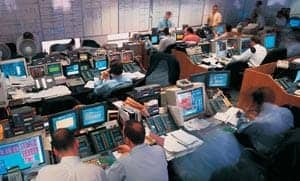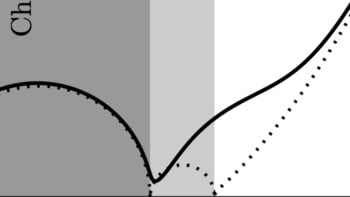My Life as a Quant: Reflections on Physics and Finance
Emanuel Derman
2004 John Wiley 304pp £19.99hb

Back in the 1960s life as a physics student in the US lay out in front of you like an optical bench. A good degree would be obtained at a well-funded university, courtesy of the Department of Energy, after which you would advance into a doctoral research topic with a passing relevance to the defence sector. Once complete, a government job would be waiting in an area such as radar. Or you would take one of the many permanent lectureships on offer at a university. It wasn’t quite the “summer of love”, but physicists had it relatively easy.
As the decade drew to a close, however, a chain of events was set in motion that destroyed this rosy picture. The first was the energy crisis, during which the price of oil shot up to a present-day equivalent of $180 per barrel. The world was becoming more risky and financial institutions needed help in understanding it. As the US economy felt the impact of this energy crisis with raging inflation, previously reliable government funding for science retreated – leaving an army of physicists searching for employment.
One such physicist was Emanuel Derman, who had done a PhD in particle physics at Columbia University in New York. However, he found that as one door closed another opened, this time onto the trading floor of an investment bank and into a world that had suddenly woken up to a more uncertain future. Investment banks needed people who could provide an insight into this new world and do it in a way that MBA graduates could understand. Suddenly Derman found he had the holy trinity of banking skills: a good understanding of mathematics, the ability to program computers, and – most importantly – a dirty (or should I say pragmatic?) approach to problem solving.
This book is a personal account of Derman’s journey into and through the world of finance as a quantitative analyst or “quant”. After a very traditional education in Cape Town, South Africa, he applied to do a PhD at Columbia – a decision that was to have far-reaching consequences due to its proximity to Wall Street. What follows is a familiar account of a maturing graduate student – of an eager young researcher hungry to make his academic name.
The reality for Derman turned out to be quite different. He found himself being supervised by Norman Christ and spent seven years studying for a PhD in the phenomenology of electron-quark scattering. Names that will be familiar from today’s textbooks fill the pages, and Derman gives some unflattering descriptions of various physicists that I will let readers discover for themselves. Throughout his time at Columbia, Derman perceived himself very much as an outsider. Indeed, it seems as though he either relishes or needs to be alone – whether taking part in his passion for running or feeling anonymous on the crowded streets of Manhattan.
A rolling treadmill of postdoc positions followed, including a short stint at Oxford, where he was hired by Chris Llewellyn Smith. His lowest ebb occurred during a spell at Boulder, Colorado. With a wife and child back in Manhattan, he spent much of his time alone, searching for an answer to the one problem that he could not solve with a calculator: should he leave “real” physics?
His initial answer was “partially”. He got a job in the not-so-free-market world at AT&T’s Bell Labs, working for a business-systems group, where he solved commercial mathematical problems. At the time Bell Labs was a hothouse for computer science, where staff developed the C programming language and UNIX operating systems. But being a massive organization with a million employees, Bell Labs had a strict hierarchy that Derman found stifling and, I imagine, a little petty.
However, this exposure to the cutting edge of computer science was essential for his later career. At one point he was even taught database theory by David Shaw, who now runs D E Shaw & Co and who reportedly lost close to $1bn with the Bank of America in the 1980s.
After five years pondering his escape from Bell Labs, Derman finally joined the Financial Strategies Group at Goldman Sachs in November 1985. Aged almost 40, he was – by today’s standards – ludicrously old to start work as a quant. Fortunately, the high inflation and high interest rates of the 1970s had by now retreated, leaving many fund managers searching for new ways to enhance return. Derman’s first job was to value “long-dated call options” on bonds, which would then be bought from bank clients to enhance their yield.
This was an extremely lucrative business in the 1980s and immediately put Derman near to “the money” by letting him liaise with the sales people who gave the price to the client, and to the traders who would then “hedge” the position. For those looking for a job in the City, it is interesting to note that the biggest improvement he made to this model was a user-friendly interface.
It was at Goldman’s that Derman met the legendary economist Fischer Black, with whom he later collaborated. Apart from describing some of the research that he did, Derman reveals that he had finally found an environment in which he felt comfortable. During the 1980s Goldman’s was a rather collegiate place with only 5000 employees and a free canteen, which makes it surprising that he left to work for the infamously tough and political Solomon Brothers. This was a decision Derman almost immediately regretted, and he returned to Goldman’s only a year later.
Towards the end of the book, Derman goes into great detail about the Kingdom of Denmark Nikkei “put options”. This was a deal that I imagine made his name at Goldman’s and marked his transition from a physicist who could merely program to one who could implement a solution to a client’s needs. He also indicates that this was the start of a new revolution in the financial markets with engineers “slicing and dicing” risk like quantitative sushi chefs. His opinions on the elusive unified theory of financial economics are required reading for physicists who are contemplating a career change but are still hanging on to academic perfection.
It was the events in lower Manhattan on 11 September 2001 that encouraged Derman to leave Goldman Sachs for an academic post back at his alma mater Columbia. The reader may be left with numerous questions about how physicists can “make it” in the City, but Derman provides only some of the answers and even then in a cryptic way. Still, this is a well-observed and insightful book written by a man who found himself at the beginning of a finance revolution and the birth of a radical and lucrative career opportunity for physicists that still exists today.



